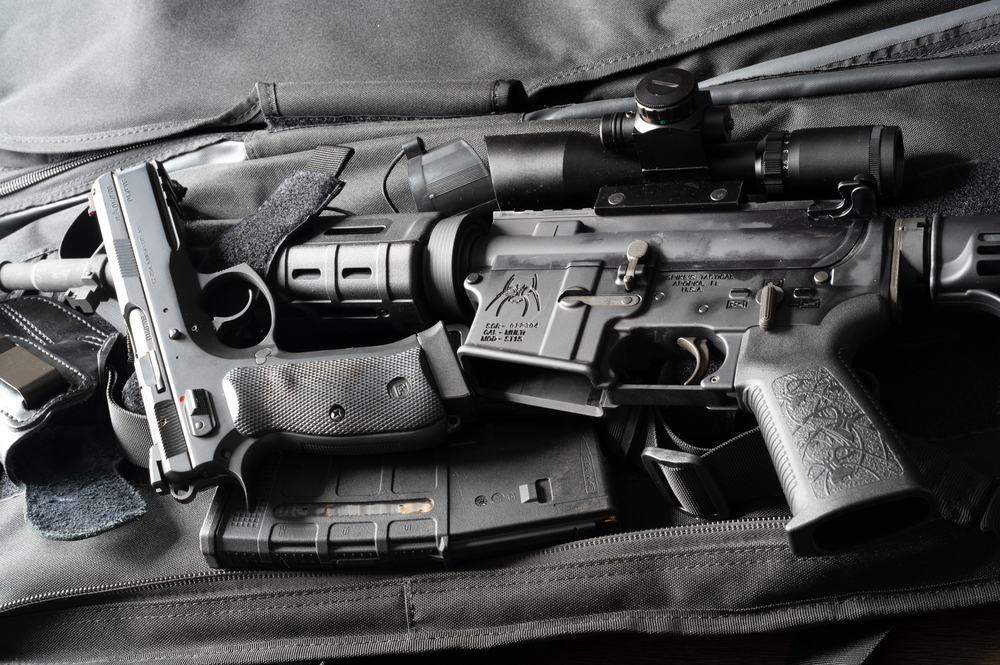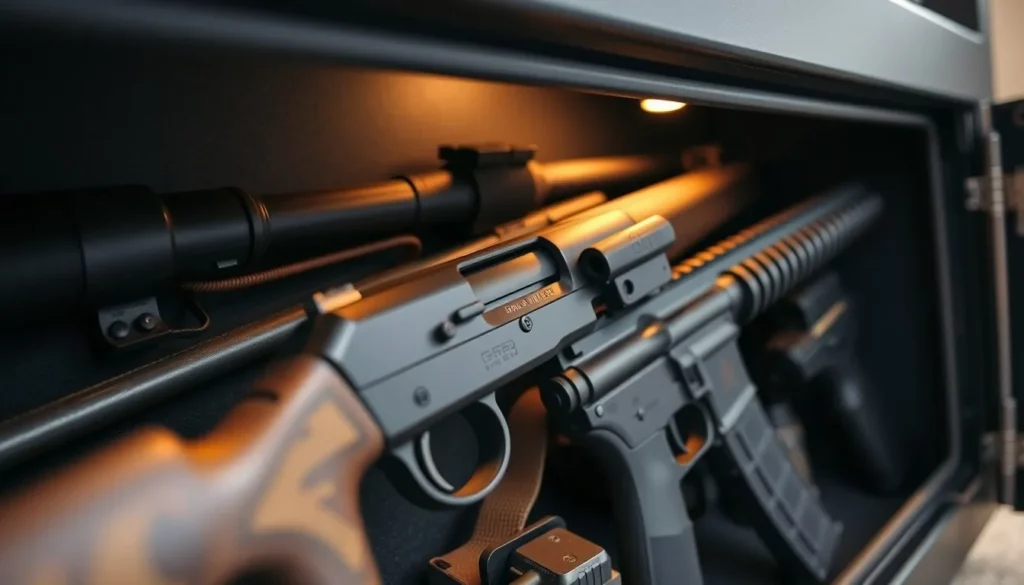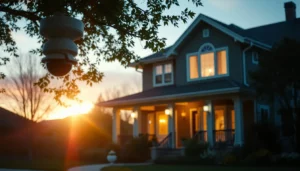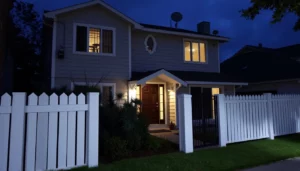In today’s blog post, we are going to talk about how to choose a gun for home defense.
Protecting your home and family starts with choosing the right tool for the job.
When it comes to home defense, selecting the right gun can feel overwhelming given the sheer number of options out there.
The goal is to find one that suits your needs, is easy to handle, and ensures safety for everyone in your household.
Let’s break it down so you can make an informed decision.

Protect your family and property in uncertain times!
Before we continue, let me introduce you to Guerilla Home Defense — the ultimate survival guide for navigating the uncertain times ahead.
Covering all three stages of the impending crisis in America, this guide equips you with the tools to protect your home from the surge in crimes like break-ins and attacks, handle the chaos of riots and looting, and even prepare for the potential of civil war.
If you’re serious about staying safe when disaster strikes, Guerilla Home Defense is a must-have resource.
How to Choose a Gun For Home Defense Quick Guide
- Consider factors like caliber, reliability, ease of use, and safety features when selecting a home defense gun.
- Popular options include pistols (Glock 19, S&W M&P Shield), shotguns (Remington 870, Mossberg 590), and rifles (AR-15, Ruger PC Carbine).
- Understand gun safety rules and concealed carry laws in your area.
- Choose a firearm that you can handle comfortably and effectively based on your specific needs.
- Invest in professional firearm training courses and practice regularly for responsible gun ownership and home protection success.
Understanding Your Home Defense Needs
Choosing a firearm for home defense starts with understanding your situation.
Take a close look at your home’s layout, the types of threats you might encounter, and your level of experience with firearms.
The home defense gun you select should match your comfort level and offer practical protection for your household.
Home Defense Scenarios to Consider
Think about the unique challenges your home presents:
- Do tight spaces or long hallways limit your movement?
- Are you responsible for protecting multiple people in different rooms?
These factors play a significant role in determining what firearm is best suited for your defense plan.
Addressing Risks With Firearms
Be aware of potential hazards, like overpenetration, where bullets might travel through walls and harm unintended targets.
Choosing the right caliber and ammunition reduces this risk significantly.
It is equally important to store your firearm in a secure but accessible location to ensure safety while keeping it ready for emergencies.
Exploring Non-Lethal Alternatives
Firearms aren’t the only option for home defense.
There are non-lethal options, such as pepper spray, stun guns, and personal alarms that can also deter intruders.
Decide what you’re most comfortable with and whether you’re prepared to invest time in learning how to use a firearm effectively if you choose that route.
Recommended Home Defense Gun Options

Pistols: A Popular Choice for Home Defense
Pistols are a favorite choice for home defense due to their compact size, ease of use, and high ammunition capacity.
Models like the Springfield Armory Echelon and Glock 19 are widely recommended.
The Echelon, priced at $679, offers a magazine capacity of 17 to 20 rounds, while the Glock 19, available for $539, boasts a stellar 4.90/5 rating from over 3,000 users.
Other reliable options include the Walther PDP, Smith & Wesson M&P9 M2.0, and HK VP9.
When selecting a pistol, focus on reliability, comfort, and compatibility with accessories like lights or optics.
While 9mm is a popular caliber, alternatives like .40 S&W or .45 ACP are worth considering based on personal preference and shooting ability.
Ultimately, the best pistol is the one you can handle confidently under stress.
Shotguns: The Classic Home Defense Firearm
Shotguns remain a classic choice for home defense because of their stopping power.
The 12-gauge and 20-gauge are the most commonly used, with buckshot loads being especially effective.
Popular models include the Mossberg 590A1, Remington 870 Tactical, Benelli M4, and Beretta A300 Ultima Patrol. These options are reliable and offer sufficient ammunition capacity for emergencies.
Aiming is crucial when using a shotgun, contrary to the myth that precision isn’t necessary.
While the distinct sound of a pump-action shotgun can deter intruders, it’s not a guarantee and might even escalate a situation.
Ammunition selection matters; buckshot can overpenetrate, so No. 4 shot with modern wads may be a safer choice.
Additionally, shotguns can have strong recoil, making practice essential for comfortable use.
Rifles: An Option for Larger Homes
For homeowners with larger properties, rifles, particularly AR-15 style carbines, can provide an advantage. These firearms offer excellent accuracy, extended range, and substantial magazine capacity, typically chambered in .223 Remington or 5.56 NATO.
However, the high velocity of these rounds can lead to overpenetration, posing risks to bystanders. Using fragmenting ammunition can mitigate this issue, and creating a reliable backstop within your home adds an extra layer of safety.
Mobility is another factor to consider.
Shorter rifles or AR pistols are better suited for indoor use, allowing for easier navigation through tight spaces.
Training is essential — not just for marksmanship but also for maneuvering within your home’s layout and ensuring proper storage.
Factors to Consider When Choosing a Home Defense Gun

Picking the right firearm for home defense is a big decision, and there are several factors to weigh before making your choice.
Gun Calibers
For handguns, 9mm Luger and .38 Special are popular options. They offer a good balance of power without excessive recoil.
If you’re considering a rifle, .223/5.56mm rounds are effective and minimize the risk of overpenetration.
Shotguns, especially 12-gauge, are solid for close-quarters defense with their wide spread.
Reliability
A reliable firearm is non-negotiable.
Stick with reputable brands like Glock, Sig Sauer, and Smith & Wesson, as their guns are known for dependable performance.
Look for features like manual safeties and chamber indicators to ensure your gun functions properly when needed.
Load Capacity
The number of rounds your firearm holds and how quickly you can reload are crucial.
Semi-automatic handguns generally offer higher capacity and faster reload times compared to revolvers.
Rifles, like the AR-15, can carry large magazines for extended shooting.
Shotguns typically hold 4 to 8 shells, but some models have detachable magazines for quicker reloading.
Training and Practice: The Key to Effective Home Defense

Owning a gun for home defense is only the first step. The real work comes with learning how to use it safely and effectively.
Professional training is essential to ensure you’re prepared when it matters most.
Shooting Range Practice
Frequent practice at the shooting range is crucial.
Aim for at least one visit a month, and focus on drills that simulate real-life scenarios.
Training classes that teach self-defense, low-light shooting, and stress management are especially valuable. These skills can make all the difference in an emergency, helping you stay calm and respond quickly.
Decorated Green Beret Reveals:
Home Practice
You can also improve your skills between range visits with dry fire practice.
This involves practicing with an unloaded gun, focusing on your aim, trigger control, and handling. It’s a simple yet effective way to stay sharp at home.
Remember, owning a firearm for home defense comes with serious responsibility.
Consistent training and practice are key to making sure you’re ready to protect yourself and your loved ones.
Make it a priority to train regularly and keep your skills sharp.
Accessorizing Your Home Defense Gun
If you’re serious about optimizing your home defense setup, adding a few well-chosen accessories to your firearm can make a significant difference in both performance and your ability to respond quickly and effectively in a high-stress situation.
Tactical Flashlights
FREE Light Saver Tactical Torch
In a home defense situation, it’s critical for identifying potential threats in the dark, especially if an intruder is trying to hide or move stealthily.
The right tactical flashlight not only helps you see clearly but can also disorient and temporarily blind an attacker.
Look for models that are designed to withstand the recoil of your firearm.
A high lumen output (around 500 lumens or more) is ideal, and a compact, durable design is essential for mounting on your gun without adding too much bulk.
Red Dot Sights
Red dot sights are an excellent addition for those seeking quick, precise aiming in high-pressure situations.
These sights project a red dot onto your target, allowing you to maintain situational awareness without having to focus on traditional iron sights.
This can be a game-changer in the event of a home defense scenario, where every second counts.
Red dot sights also improve target acquisition, reducing the time it takes to line up your shot, and they are available in various configurations, from simple reflex models to more advanced magnified optics.
Ensure the sight you choose is rugged enough for regular use and offers battery life that can last in a crisis.
Some models even offer night vision compatibility, making them perfect for low-light conditions.
Night Sights
Night sights are designed to help you aim accurately in low-light conditions, which is crucial if you need to defend your home after dark.
These sights typically use tritium or fiber-optic technology to provide glowing sights that are visible even in complete darkness.
The advantage of night sights is that they allow you to aim without the need for a flashlight or additional light source, preserving your tactical advantage.
Choose a set that’s easy to install, compatible with your firearm, and built to withstand regular wear and tear.
Night sights not only enhance your accuracy in the dark but also help you maintain a quick draw, which is essential during a stressful home defense situation.
Grip Upgrades
Upgrading the grip on your gun can improve your comfort, accuracy, and overall control during rapid shooting.
Different grip textures and materials can help you maintain a better hold, reduce slippage, and improve recoil management.
Consider grips that are ergonomically designed to fit your hand size and shooting style.
Additionally, custom grips can provide you with the added benefit of reducing hand fatigue, making it easier to control the firearm for extended periods.
These accessories, when combined with solid training, can enhance your preparedness and confidence in defending your home against potential threats.
Maintaining Your Home Defense Firearm
Proper maintenance is essential for ensuring that your home defense firearm functions reliably when you need it most.
Clean Regularly
Regular cleaning is a must.
Invest in a quality gun cleaning kit, and follow the manufacturer’s instructions for both cleaning and lubrication. This will prevent buildup, rust, or any other issues that could compromise the firearm’s performance.
Make it a habit to inspect your gun for signs of wear or damage, such as cracks, loose parts, or corrosion.
Address any issues immediately to avoid malfunctioning when under pressure.
Storing Properly
Equally important is storing your firearm properly.
A sturdy, locked safe or cabinet is necessary to prevent unauthorized access, especially in a household with children or visitors.
Consider a safe with fire and water resistance for added protection.
To prevent rust, store the gun in a low-humidity environment, and use dehumidifiers or desiccants inside the safe. This will ensure the firearm remains in optimal condition, free from moisture that can cause long-term damage.
Legal Considerations for Owning a Home Defense Gun
Owning a home defense gun is also about a commitment to understanding and abiding by the laws that govern gun ownership in your area.
Each state has its own set of legal requirements and restrictions, so it’s essential to know what applies to you.
For example, certain states protect homeowners under laws such as the Castle Doctrine or Stand Your Ground, which give you the right to defend your home with force if necessary.
These laws can offer peace of mind, knowing that you’re legally backed if you have to act in a dangerous situation.
On the other hand, some regions have stricter rules that regulate how, when, and where you can use or carry a firearm.
Taking responsibility for legal compliance is crucial for both your safety and your peace of mind. Make sure to fully understand the legal framework in your area before purchasing or carrying a home defense weapon.

Protect your family and property in uncertain times!
Before we continue, let me introduce you to Guerilla Home Defense — the ultimate survival guide for navigating the uncertain times ahead.
Covering all three stages of the impending crisis in America, this guide equips you with the tools to protect your home from the surge in crimes like break-ins and attacks, handle the chaos of riots and looting, and even prepare for the potential of civil war.
If you’re serious about staying safe when disaster strikes, Guerilla Home Defense is a must-have resource.
Conclusion
Choosing a home defense gun isn’t rocket science, but it does take serious thought.
Your safety comes down to picking a weapon you can actually use, getting real training, and understanding how to handle it right.
The best gun is the one you’re comfortable with and can shoot accurately when it matters most. That means spending time at the range, learning your weapon inside and out, and keeping it maintained and secured.
Don’t get caught up in fancy gear or macho fantasies. This is about protecting your family, plain and simple.
Take some classes, practice regularly, and know the laws in your area.
A gun isn’t a magic solution. It is a tool that requires skill, responsibility, and constant attention. The moment you start thinking you’re an expert is the moment you become dangerous.
Bottom line: Pick a reliable weapon, train hard, stay safe, and always think about protecting what matters most.







